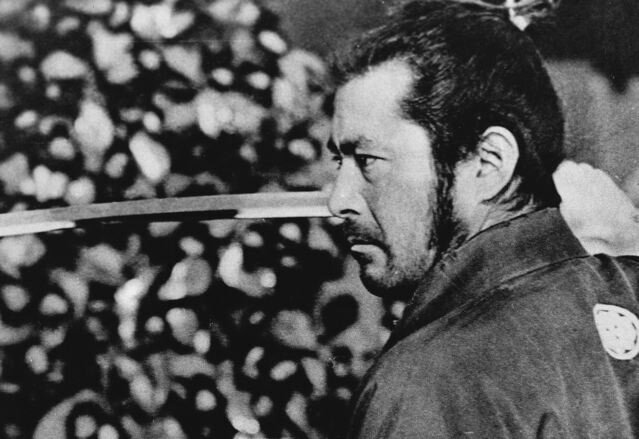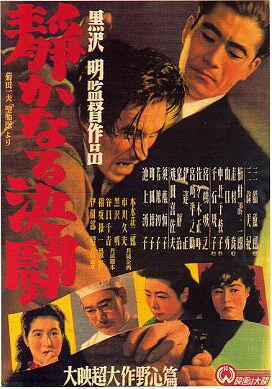You are hereNewspapers 1970-1979 / Akira Kurosawa
Akira Kurosawa
Swords of the Orient

Toshiro Mifune in Sanjuro: fastest sword in the east.
By TOM SOTER
from the COLUMBIA DAILY SPECTATOR, April 19, 1977
Japanese movies have gained a bad reputation in recent years through the efforts of such films as Godzilla vs. Megalon, King Kong vs. Godzilla, and Godzilla vs. the World (among others). That's too bad, because the Japanese have made some excellent movies, and not only for the art-house fans.
Foremost among these is the work of Akira Kurosawa. Since his first movie in 1943, he's directed 26 films, ranging from gangster melodramas, and human relationship pieces, through samurai epics. In all these genres he's shown an uncanny knack for fascinating and understated character revealing a lot about Japanese customs and Japanese humor, as well.
His best known film is Rashomon, an exploration of truth,. which was released here in the early 1950's and which then caused quite a stir. Before it, no one knew that the Japanese even made movies, let alone ones of the caliber of Rashomon. Today, it is interesting for these historical reasons, but hardly as rewarding or entertaining as The Seven Samurai, Yojimbo, or Sanjuro. The latter two films star Toshiro Mifune as a samurai for hire, a sort of Japanese Clint Eastwood. However, where Eastwood stonefaces his way through most of the spaghetti westerns, Mifune brings both wit and charm to his taciturn loner who sets about cleaning up the bad guys as the "fastest sword in the east" (to coin a phrase).

Toshiro Mifune in The Quiet Duel.
The samurai film is to Japanese audiences what the Western is to Americans, and it's no surprise that Kurosawa is a big John Ford fan. His staging and use of the screen space is remarkable; at times one feels as though one were watching an unlikely ballet of violence. And Mifune has a grace about him that is seemingly belied by his rough appearance.
In addition, Kurosawa manipulates his characters and story-line excellently, and audiences who have only been exposed to the slow-paced works of directors like Ozu are surprised at how gripping and Western-seeming films like Yojimbo are.
"In Kurosawa," Japanese film expert Donald Richie once explained, "realism reaches its fullest expression. At the same time, however, the realism is controlled and tempered by a style which, though personal and contemporary, is part of the Japa.'lese aesthetic. "
In Yojimbo and Sanjuro, its sequel, all three of these qualities are evident. And beca use of that, the movies are as fresh today as when first released, and as revealing about Japanese culture and thinking as they are entertaining. From the first close-up shot of the hulking Mifune's back, accompanied by the pulsating Masaru Sato score, through the last "Adios" you'll find yourself riveted. At least I was,· and have been a Japanese movie buff and Kurosawa-Mifune fan ever since.
Both films will be shown this Thursday, Friday and Saturday at the Regency Theater as part of their Japanese Film Festival.
